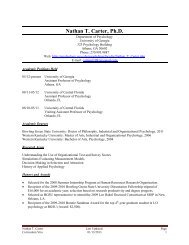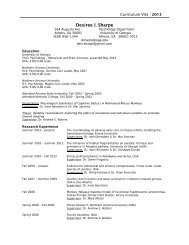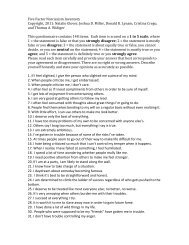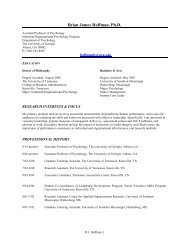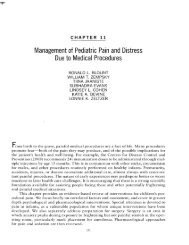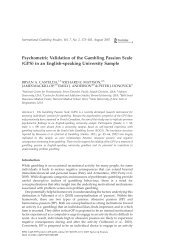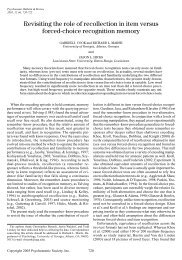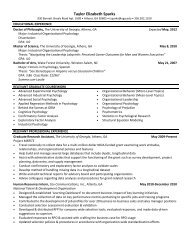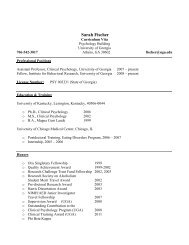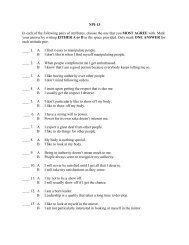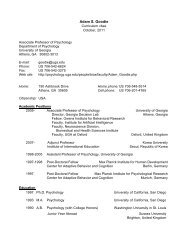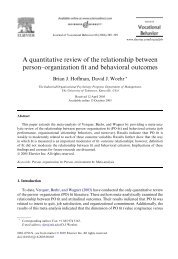Dear Author, Here are the proofs of your article. ⢠You can submit ...
Dear Author, Here are the proofs of your article. ⢠You can submit ...
Dear Author, Here are the proofs of your article. ⢠You can submit ...
Create successful ePaper yourself
Turn your PDF publications into a flip-book with our unique Google optimized e-Paper software.
Journal : Small 10899 Dispatch : 4-4-2012 Pages : 14<br />
Article No. : 9303 h LE h TYPESET<br />
MS Code : JOGS637 h4 CP h4<br />
DISK<br />
J Gambl Stud<br />
<strong>Author</strong> Pro<strong>of</strong><br />
121 individual difference variables. Individuals were excluded from participation if <strong>the</strong>y: (1)<br />
122 did not gamble at least once a week, (2) currently lived with someone who already<br />
123 completed <strong>the</strong> study, (3) could not use a computer, (4) reported symptoms <strong>of</strong> psychosis, or<br />
124 (5) were older than 65.<br />
125 Procedure<br />
126 Eligible individuals completed a single in-person session, in which <strong>the</strong>y first completed a<br />
127 demographic questionnaire on a computer in an individual lab room, next took part in a<br />
128 one-on-one diagnostic interview with a trained masters-level interviewer to determine<br />
129 gambling pathology, and finally completed <strong>the</strong> assessment <strong>of</strong> gambling, alcohol use, and<br />
130 tobacco use within <strong>the</strong>ir social networks. All procedures were approved by <strong>the</strong> University<br />
131 <strong>of</strong> Georgia Institutional Review Board and were consistent with <strong>the</strong> Helsinki Declaration.<br />
132 Participants were paid $30 US for <strong>the</strong>ir participation in <strong>the</strong> overall study.<br />
133 Measures<br />
134 Diagnostic Interview for Gambling Severity (DIGS; Winters et al. 1996)<br />
135 This semi-structured clinical interview is based on <strong>the</strong> 10 DSM-IV diagnostic criteria for<br />
136 PG. The 20 items <strong>are</strong> paraphrased directly from <strong>the</strong> DSM-IV criteria, with 2 items for each<br />
137 criterion, grouped into pairs to reflect <strong>the</strong> dichotomous nature <strong>of</strong> <strong>the</strong> 10 criteria. Following<br />
138 a face-to-face interview, a trained interviewer determined whe<strong>the</strong>r each item was false,<br />
139 somewhat true, orvery true, based upon <strong>the</strong> participants’ responses. Within each <strong>of</strong> <strong>the</strong><br />
140 item pairs, two classifications <strong>of</strong> somewhat true or at least one answer <strong>of</strong> very true resulted<br />
141 in <strong>the</strong> participant receiving a point. The total score was assessed on a scale <strong>of</strong> 1–10, with a<br />
142 score <strong>of</strong> 5 or higher indicating PG status. Administration <strong>of</strong> <strong>the</strong> DIGS probes specific<br />
143 gambling modalities including playing cards, betting on sporting events, playing <strong>the</strong> lottery<br />
144 and playing slot machines, but it does not mandate that gambling-related problems be<br />
145 restricted to <strong>the</strong>se forms <strong>of</strong> gambling. Participants reported engaging in a wide range <strong>of</strong><br />
146 gambling activities, including lottery play, cards, dice, sports betting and internet gaming.<br />
147 Alcohol Use Disorders Identification Test (AUDIT; Saunders et al. 1993)<br />
148 This 10-item assessment addresses <strong>the</strong> frequency, amount, and possible consequences <strong>of</strong><br />
149 alcohol consumption. Total scores <strong>can</strong> range from 0 to 40 with a score <strong>of</strong> 8 or higher<br />
150 indicating hazardous drinking.<br />
151 Fagerstrom Test for Nicotine Dependence (FTND; Hea<strong>the</strong>rton et al. 1991)<br />
UNCORRECTED PROOF<br />
152 The FTND is used to assess nicotine dependence by assigning a nicotine rating from 1 to<br />
153 10, as based on particular smoking behaviors that individuals endorse. The FTND has been<br />
154 shown to have good convergent validity with various biochemical measures <strong>of</strong> smoking,<br />
155 including cotinine and nicotine in saliva (Hea<strong>the</strong>rton et al. 1991).<br />
123



